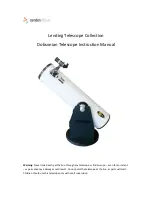
Loosen the three chrome screws around the outside of the camera adapter. Slip the
camera adapter over the telescope’s zoom eyepiece. Slide it as far down as you can
and then gently tighten the screws until your camera is securely hold over the eyepiece.
(See below.)
You can now take pictures through the telescope with your camera. We strongly
recommend using films with ISO ratings of at least ISO 200. ISO 400 films are
preferred.
Caution: Attaching a camera body to the telescope will offset the stability of the
assembled unit. Care should be taken to prevent the equipment from falling over.
Note: One of the effects of the Maksutov design is that some highlight reflections, such
as those seen from sunlit water or metal, will show in your pictures as tiny “donuts” or
circles. This is most often seen if these highlights are slightly out of focus. This effect is
normal.
USING YOUR TELESCOPE FOR ASTRONOMICAL VIEWING
1) Take your telescope outside. We do not recommend viewing objects through a
window. Your view can be distorted by reflections in the glass of a closed window or
by air currents of differing temperatures passing through an open window.
2) Allow your telescope to adjust to the outside temperature. Your telescope will
perform much better if the temperature of the lenses and the air inside the tube are
the same as the outside temperature. We recommend that you allow 30 minutes to
equalize the temperatures when the difference in temperature difference is extreme.
If you try to use the telescope before it has adjusted to the outdoor temperature you
may find it somewhat difficult to focus accurately.
3) Find a location away from any direct light source. If you live in a large town or city,
your viewing will probably improve the farther you move away from the ‘light
pollution’ of city lights. The sky glow of a town or city can dramatically reduce the
telescope’s performance and viewing capabilities.
4) Remove the round plastic dust cover (lens cap) from the front of your telescope.
6



























